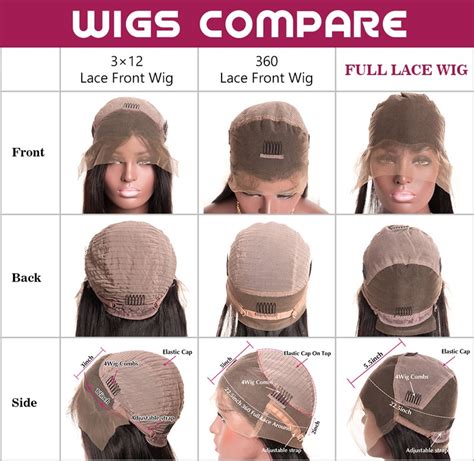Types of Wigs for Men
Wigs have become increasingly popular among men as a stylish and convenient way to enhance their appearance. With a wide variety of options available, finding the perfect wig to suit your needs and preferences is essential. This comprehensive guide explores seven distinct types of wigs for men, each offering unique advantages and characteristics.

1. Lace Front Wigs
Features:
- Thin, delicate lace material creates a natural-looking hairline
- Provides the illusion of hair growing directly from the scalp
- Allows for versatile styling options, including updos and ponytails
Pros:
- Most realistic appearance
- Comfortable and breathable
- Long-lasting with proper care
Cons:
- Expensive
- Requires professional installation and maintenance
2. Polyurethane Skin Wigs
Features:
- Made from thin, durable polyurethane material
- Bonds directly to the scalp using adhesive
- Creates a secure and undetectable hold
Pros:
- Durable and water-resistant
- Offers excellent breathability
- Can be worn for extended periods without discomfort
Cons:
- Can be challenging to apply and remove
- May require frequent adjustments
- Not suitable for sensitive skin
3. Monofilament Wigs
Features:
- Constructed on a sheer monofilament cap
- Allows hair to be parted and styled in any direction
- Provides a natural scalp-like appearance
Pros:
- Lightweight and breathable
- Simulates natural hair growth patterns
- Easy to style and maintain
Cons:
- Less durable than other wig types
- Can be more expensive
- May not be suitable for all head shapes
4. Synthetic Wigs
Features:
- Made from artificial fibers such as acrylic, nylon, or polyester
- Available in a wide range of colors, styles, and textures
- Heat-resistant, allowing for styling with heat tools
Pros:
- Affordable
- Easy to care for and maintain
- Durable and long-lasting
Cons:
- Less realistic appearance than human hair wigs
- Can feel less breathable
- May become frizzy or tangled
5. Human Hair Wigs
Features:
- Constructed from real human hair
- Offer the most natural and realistic look
- Can be styled, colored, and cut like natural hair
Pros:
- Unmatched quality and appearance
- Durable and long-lasting
- Versatile and customizable
Cons:
- Expensive
- Requires regular care and maintenance
- May be susceptible to damage from heat styling
6. Custom-Made Wigs
Features:
- Designed and tailored specifically for the wearer’s head shape and preferences
- Uses high-quality materials and construction techniques
- Offers unparalleled fit and comfort
Pros:
- Perfect fit and appearance
- Meets specific style and color requirements
- Designed to last for years
Cons:
- Most expensive wig option
- Requires a lengthy manufacturing process
- May require professional maintenance
7. Virtual Reality (VR) Wigs
Features:
- Immersive experience that allows users to try on wigs digitally
- Provides realistic 3D simulations of different wig styles and colors
- Helps users make informed decisions before purchasing
Pros:
- Convenient and time-saving
- Accurate simulations for realistic visualization
- Eliminates the need for in-person appointments
Cons:
- May not fully replicate the feel and fit of a physical wig
- Requires access to specialized VR equipment
- Limited availability compared to traditional wigs
Comparison Table
| Wig Type | Appearance | Durability | Cost | Maintenance |
|---|---|---|---|---|
| Lace Front Wigs | Most realistic | Moderate | High | Professional |
| Polyurethane Skin Wigs | Undetectable | High | Moderate | Adhesive required |
| Monofilament Wigs | Natural scalp-like | Moderate | Moderate | Easy |
| Synthetic Wigs | Less realistic | High | Low | Easy |
| Human Hair Wigs | Most natural | Moderate | High | Regular care |
| Custom-Made Wigs | Perfect fit | High | Very High | Professional |
| Virtual Reality (VR) Wigs | Immersive experience | N/A | Low | Digital only |
Pain Points and Motivations
Pain Points:
- Hair loss due to medical conditions or aging
- Desire for a new look or style
- Thinning hair or bald spots
- Lack of confidence in appearance
Motivations:
- Enhance self-esteem and confidence
- Improve appearance and overall well-being
- Explore new hairstyles and colors
- Address hair-related concerns
Frequently Asked Questions (FAQs)
1. What is the best type of wig for a natural look?
Lace front wigs and polyurethane skin wigs offer the most realistic appearance.
2. How long do wigs typically last?
The lifespan of a wig depends on the type and quality. Synthetic wigs can last 3-6 months, while human hair wigs can last up to 2 years or more.
3. How much do wigs cost?
Prices range from $100 for affordable synthetic wigs to $2,000 or more for high-quality human hair custom-made wigs.
4. Can I wash and style wigs?
Yes, most wigs can be washed and styled, but following the manufacturer’s instructions is essential to avoid damage.
5. Are wigs comfortable to wear?
The comfort level varies depending on the wig type, materials, and fit. Lace front and monofilament wigs are designed to be lightweight and breathable.
6. How often should I replace my wig?
The frequency of replacement depends on the usage and care. Synthetic wigs may need to be replaced every 3-6 months, while human hair wigs can last for years.
7. Where can I purchase a wig?
Wigs can be purchased from beauty supply stores, salons, or online retailers. Custom-made wigs require consultation with a wig specialist.
8. How can I care for my wig?
Maintaining a wig involves washing, styling, and storage. Follow the manufacturer’s instructions carefully to extend the lifespan of your wig.
